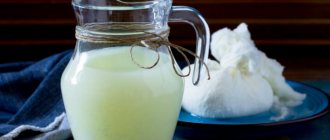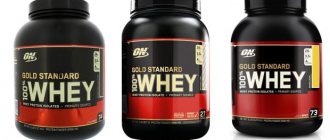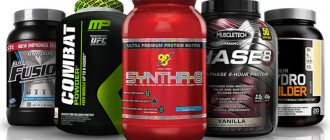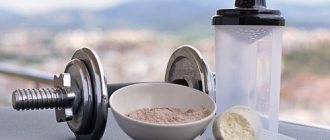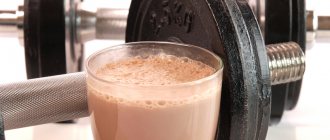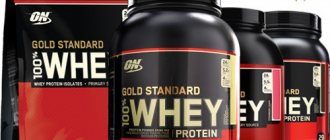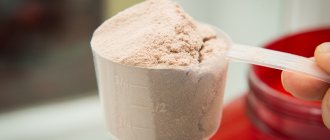04.11.2021
What is protein and why is it needed?
Protein (protein, polypeptide) is a chain of amino acids connected by a peptide bond. Proteins form all cells and tissues in the human body. There are enzyme proteins required for various biochemical processes, some with mechanical or structural functions, others involved in signal transduction, immune response, cell cycle, etc. (1).
The human body cannot exist without proteins supplied from the outside along with food, because it does not synthesize all amino acids (amino acids that the body does not synthesize on its own are called essential). Protein consumed in food is broken down by digestive enzymes into amino acids, from which new proteins are formed, for example, muscle tissue. Some amino acids do not form new proteins and are used by the body in their original form, for example, glycine acts as a neurotransmitter in the central nervous system (transmits a signal from a nerve cell between neurons) (2).
In the context of healthy eating and sports
Protein is consumed to supplement the natural diet to increase its nutritional value. A serving of protein can replace a meal or supplement it by increasing the amount of protein consumed. Protein is widely used in diets, most often for weight loss; for example, caseins supply the body with nutrients for a long time and suppress hunger. They are convenient to take when you know that you will not eat for a long time; slowly digestible protein will protect the body from destructive processes associated with a long absence of nutritious food. If there are special uses for protein, for example, egg white helps regulate blood glucose levels, which is why it is included in diets for diabetics.
Protein is also taken when there are errors in the diet in order to eliminate the lack of essential amino acids, which can lead to various pathological processes. For example, if the body lacks the essential amino acid cysteine, a number of processes are disrupted, from glucose absorption to DNA synthesis(3).
In professional and amateur sports, protein is used for accelerated muscle growth, rapid recovery between workouts, and weight loss. Protein is the most researched nutritional supplement used in sports, its effectiveness has been confirmed by hundreds of scientific experiments (4,5,6).
What is protein and what is the difference?
Protein as a food additive can be divided into two large groups based on the origin of the raw material - animal (for example, whey concentrate) and plant (for example, soy isolate). Animal protein is also divided into groups - whey (it is obtained from whey), casein, meat (for example, from beef), egg. Below we describe in detail the most popular types of protein.
Whey Protein
Presented in three types - concentrate, isolate, hydrolyzate. All types of whey protein are obtained from the whey left over from the curdling of milk in cheese production. Whey is separated from milk by filtration, then undergoes short-term high-temperature treatment (pasteurization) for disinfection. All moisture is then removed from the whey, resulting in concentrated protein(7). This is whey concentrate.
The concentrate contains about 80% protein, 8% carbohydrates, 5% fat. It has a complete amino acid profile (all 20 proteinogenic amino acids). About 21% of the amino acids in whey concentrate are BCAA, branched chain amino acids. BCAA's include leucine, isoleucine and valine. These amino acids are involved in many metabolic processes and are valued in sports for their active role in building new muscle fibers (8).
Whey concentrate is quickly absorbed, it is suitable for gaining muscle mass, accelerated recovery, weight loss, special diets, for example, it can be taken during pregnancy and lactation, suitable for children (only after consultation with a doctor).
Whey isolate differs from concentrate by an additional step in production - this is the step of protein isolation, that is, the removal of lactose, animal fat, lactoferrin, simple globulins and some other substances from whey (9). Compared to concentrate, isolated whey protein has more protein in its composition - from 90%, respectively, it contains less carbohydrates and fats. The second advantage is that there is less lactose, which means people who have problems digesting milk sugar can consume isolate without the risk of disrupting digestion.
Please note - it all depends on the degree of sensitivity to lactose. Many athletes cannot take concentrate but use isolate freely, while others cannot take any form of whey protein(10). There is also lactose in isolate, it’s just much less of it than in concentrate, so with mild intolerance, the body, as a rule, does not react to such a small amount.
The third form of whey protein is hydrolyzate. It is also made from sweet cheese whey. The difference is that the concentrated protein obtained by filtration is partially destroyed by hydrolysis (hence the name hydrolyzate). Hydrolysis breaks down about 25% of the protein into individual amino acids. It turns out that part of the protein does not need to be fermented in the digestive tract; amino acids immediately go to work. This is the advantage of hydrolyzate over other forms of whey protein - it is absorbed faster (11).
In terms of price, concentrate is the cheapest, isolate is more expensive, hydrolyzate is the most expensive. For amateur athletes without lactose intolerance, a concentrate is sufficient. Isolate is purchased if intolerance occurs or there are dietary requirements (for example, for weight loss, because isolate contains less fat and carbohydrates). Hydrolyzate is purchased by professional athletes because, due to its increased absorption rate, it provides the greatest effect in terms of muscle growth and recovery.
What are the benefits of protein shakes?
High-quality protein powders contain a number of beneficial substances, including antioxidants and amino acids. Research has shown that athletes need increased amounts of protein to support muscle recovery after intense training. Moreover, taking extra protein powder will help replenish your energy and combat hunger.
The effectiveness of any protein shake depends on the quality of the powder, so try to choose organic whey protein concentrate and avoid isolates and powders that contain artificial ingredients.
Rennet and micellar casein
Rennet casein is a complex protein that is obtained from caseinogen during the enzymatic curdling of milk. As a rule, rennet casein contains at least 90% protein. Its peculiarity is that it is absorbed for a long time, that is, it saturates the body with nutrients for a long time (12).
Rennet casein has the same effects as whey protein and is taken to accelerate muscle growth and recovery. The specificity is determined by prolonged absorption - casein is used during diets aimed at losing weight. It is a much stronger appetite suppressant than whey proteins. If you know you won't be able to eat for a long time, rennet casein will provide your body with nutrients and protect your muscles from breakdown.
Rennet casein has a high degree of purification and, accordingly, low allergenicity, therefore it is used in baby food (13).
In milk, casein is present in the form of a calcium salt (the so-called bound form); to obtain casein itself, milk is either curdled or exposed to acidic reagents. Micellar casein is obtained differently - the milk is simply filtered. This allows you to preserve the native (original) form of the protein.
Like rennet casein, micellar casein is a complex protein; it exists in the form of micelles - conglomerates of protein molecules. This determines its slow absorption and appetite suppressant effect. That is, micellar casein is used for the same purposes as rennet. Both have a complete amino acid profile and are high in BCAA (less than whey). The difference is that micellar contains less protein (about 85%), respectively, more fat and carbohydrates (including lactose).
Rennet casein is more expensive than micellar casein, it is cleaner and less allergenic. In terms of target effects, they are equal.
How to use
Whey protein can be purchased online, in sports nutrition stores, and less commonly in pharmacies.
Add one scoop (about 28 grams) of powder to any liquid, such as water, almond milk, yogurt or smoothie, and mix well until smooth and lump-free.
The best time to take protein is in the morning with breakfast or after a workout.
One scoop of whey protein 30 minutes after training helps promote muscle recovery. And protein half an hour before meals will help avoid overeating and speed up the feeling of fullness.
Animal proteins
Beef hydrolysate
Received accordingly from beef. A high degree of purification (minimum fats and carbohydrates) leads to high biological value - beef hydrolyzate contains about 95-99% protein. Since the protein is partially broken down into amino acids (hydrolyzed), it is quickly absorbed (at the level of whey concentrate).
Beef hydrolyzate has a complete amino acid profile - it contains all 20 proteinogenic amino acids, so it is used for the same purposes as whey protein - as a dietary supplement, for weight loss, muscle gain, accelerated recovery (14).
Chicken hydrolyzate
Obtained from chicken meat (bones, skin, joints, tendons are not used). Chemically, it is a complex of oligopeptides, peptides and free amino acids, with amino acids making up about 30%. Therefore, chicken hydrolyzate is absorbed quickly and almost completely. Collagen accounts for about 15% of the protein part.
Compared to beef, chicken hydrolyzate is a little more expensive. It contains more BCAA - about 13.8% (beef has 8.4%). According to this indicator, animal proteins are much inferior to whey proteins, in which leucine, isoleucine and valine account for about 24% of all amino acids (15).
Beef and chicken hydrolyzate have approximately comparable prices; chicken hydrolyzate has slightly more BCAA in its composition. Both are effective as a dietary supplement for increasing the protein value of the diet, the choice depends on personal preference. Read more about these and some other “exotic” proteins in this article.
Hydrolyzed collagen
The raw material is usually beef collagen. It is partially broken down into oligopeptides by hydrolysis, which accelerates absorption. In the human body, collagen makes up about 6% of body weight; it is the main structural (fibrillar) protein - it is part of all connective tissues, joints, and skin. For this purpose, hydrolyzed collagen is taken - to improve the functional state of joints and ligaments, improve the health and aesthetics of the skin and hair (16).
Hydrolyzed collagen is not taken for muscle growth, accelerated recovery and weight loss.
Egg white
Chicken egg protein is obtained by separating the protein part and then drying it. About 80% protein in the composition, fats and carbohydrates no more than 0.1%. Egg white contains only 16 of the 20 amino acids, but it contains non-essential amino acids, so it is considered complete. There are BCAA and a lot of arginine, which causes high anabolic activity (20). Egg whites are good for muscle and mass gain and recovery, and are also used in diabetic diets (blood sugar control) (21). Priced at the same level as whey isolate.
Plant proteins
The most popular are apricot, hemp, pea, pumpkin, rice, soy, and sunflower seeds. All these are protein concentrates obtained without chemical fermentation. For example, apricot protein is produced by separating the protein and starch portions from cold-pressed crushed apricot kernels. The final product contains about 50% protein. Pumpkin contains 60% protein, pea – 80%.
The main advantage of plant proteins is that they can be eaten by vegetarians and vegans, as well as by those who cannot consume meat proteins due to religious traditions. Vegetable proteins do not contain lactose, they generally contain a minimum of food allergens, and are well digestible. Soy protein is usually presented as an isolate rather than a hydrolyzate, which means it is further purified - it contains about 90% protein and 4% plant dietary fiber, which has a beneficial effect on digestion (17).
In terms of amino acid composition, all plant proteins are inferior to animal proteins; not all of them even have a full profile of 20 proteinogenic amino acids. For example, pea protein contains almost no essential amino acid methionine, and hemp protein contains a minimum of lysine. Therefore, they are not considered complete proteins according to the WHO classification based on the volume of amino acids (18). But if for some reason you cannot consume animal proteins, plant proteins are the optimal solution. The missing amino acids can be purchased as separate supplements. In terms of price, plant proteins are relatively inexpensive, cheaper than whey proteins.
Spirulina and chlorella
These algae are high in protein (50-70% dry powder) with a complete amino acid profile. Contains all B vitamins, Vitamins C, D, A, E, microelements - potassium, calcium, chromium, copper, iron, magnesium, manganese, phosphorus, selenium, sodium, zinc. Spirulina and chlorella are popular among vegetarians and vegans as sources of complete protein, vitamins, minerals, and other nutrients (such as fatty acids) (19).
Recipes
Whey protein can also be an ingredient in the following delicious and healthy dishes:
- Protein truffles with dark chocolate. To make this delicious dessert you will need vanilla protein powder, medjool dates, rolled oats and dark chocolate. Truffles do not require baking and are great for a post-workout snack.
- Protein smoothie in a bowl. Add a spoonful of whey to a smoothie bowl with your favorite fruit. It is not only tasty, but also very nutritious.
- Healthy smoothie cocktail. A shake or smoothie with added protein powder can be taken with you and used as a snack between meals or after a workout.
conclusions
There are other types of protein, we have listed the most popular ones. You can only add multicomponent ones - these are food additives that contain several types of protein at once. Example - Multiprotein is a mixture of milk, whey and egg protein concentrates. This results in a complete amino acid profile, 19% BCAA content and rapid absorption.
Protein is selected based on goals and restrictions, including budgetary ones.
Whey concentrate is the cheapest, isolate is the most versatile. Beef and chicken are even cheaper, but the nutritional value is inferior to whey. Caseins are better suited for weight loss diets. Plant proteins are selected individually; except for algae, all plant proteins lack some amino acids. All of these proteins, with the exception of collagen, are suitable for accelerated muscle growth and recovery. 1 What are proteins and what do they do? US National Library of Medicine. 2 Protein, Biochemistry, General structure and properties of proteins, The amino acid composition of proteins, Daniel E. Koshland. 3 Cysteine/Glutathione Deficiency: A Significant and Treatable Corollary of Disease, Pietro Ghezzi. 4 ISSN exercise & sports nutrition review update: research & recommendations, Chad M. Kerksick. 5 Protein Applications in Sports Nutrition - Part I, Trisha A. McLain. 6 Effects of Protein Supplementation on Performance and Recovery in Resistance and Endurance Training, Harry P. Cintineo. 7 Whey and Whey Powders: Production and Uses, Oscar Leandro Ramos. 8 Effect of Branched-Chain Amino Acid Supplementation on Recovery Following Acute Eccentric Exercise, Trisha A. VanDusseldorp. 9 What whey protein isolate is made of, Peak Nutritionals. 10 What whey protein isolate is made of, Peak Nutritionals. 11 Advances in modifying and understanding whey protein functionality, Foegeding, EA 12 Whey protein stimulates postprandial muscle protein accretion more effectively than do casein and casein hydrolysate in older men, Bart Pennings. 13 Review of Infant Feeding: Key Features of Breast Milk and Infant Formula, Camilia R. Martin. onsiderations of a New Form of Hydrolysed Beef Powder as a Source of High-Quality Protein for Elderly Consideraciones Sobre un Nuevo Hidrolizado en Polvo Extraído desde la Carne de 14 Vacuno Como fuente de Proteínas de Alta Calidad para los Ancianos, Fernando Naclerio. 15 Protein content and amino acid composition of commercially available plant-based protein isolates, Stefan HM Gorissen. 16 Health Benefits of Collagen, WebMD. 17 Gastrointestinal digestion of dairy and soy proteins in infant formulas: An in vitro study, Thao TP Nguyen. 18 Protein and amino acid requirements in human nutrition, Report of a Joint WHO/FAO/UNU Expert Consultation. 19 Combined extractives of red yeast rice, bitter gourd, chlorella, soy protein, and licorice improve total cholesterol, low-density lipoprotein cholesterol, and triglyceride in subjects with metabolic syndrome, I-Te Lee. 20 Did You Know You Can Find All the Essential Amino Acids in Egg Whites? Amino Science. 21 Best Foods for Type 2 Diabetes, Joy Bauer.
